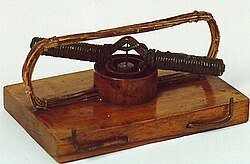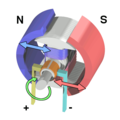Electric motor
An electric motor changes electrical energy into mechanical movement. A dynamo or an electric generator does the reverse: it changes mechanical movement into electric energy. Most electric motors work by using the force of magnetism. Electrostatic motors have also been used.
Machines using electric motors include: fans, washing machines, fridges, pumps, and vacuum cleaners.
Inside an Electric Motor
Let's start by looking at the overall plan of a simple two-pole DC electric motor. A simple motor has six parts:
- Armature or rotor
- Commutator
- Brushes
- Axle
- Field magnet
- DC power supply of some sort
An electric motor is all about magnets and magnetism: A motor uses magnets to create motion. If you have ever played with magnets you know about the fundamental law of all magnets: Opposites attract and likes repel. So if you have two bar magnets with their ends marked "north" and "south," then the north end of one magnet will attract the south end of the other. On the other hand, the north end of one magnet will repel the north end of the other (and similarly, south will repel south). Inside an electric motor, these attracting and repelling forces create rotational motion.[1]
To understand how electric motors work, the key is to understand how electromagnets work. An electromagnet is the basis of an electric motor.
Electric motors are broadly classified in to two different categories i.e. DC (direct current) and AC (Alternating current). With in these categories there are numerous types, each offering unique abilities that suit them well for best applications.
History
In 1821, Michael Faraday made the first electric motor. It worked using the force of magnetism.
He created a simple electromagnet by taking a nail and a wire, wrapping about 100 loops of wire around the nail and connected it to a battery. With this he had a simple electromagnet with north and south pole. In the middle of the nail he had made a hole and put a spindle into the hole so that the nail could rotate. He then took a horseshoe-shaped magnet and placed the wire wrapped nail in the middle.
He connected the wire of the north pole to the negative pole of the battery and the wire of the south pole to the positive pole. The basic law of magnetism told him what would happen: the north end of the electromagnet would repel the north end of the horseshoe-shaped magnet and would attract the south pole. The same happened on the other side of the nail, with the result that the nail turned.
However, Faraday was not happy with the results because the electromotor turned only once. He later discovered that by simply wrapping the wire multiple times around the nail, he could cause the polarity to change back and forth. These additional "turns" around the nail, caused the wire-wrapped nail to turn continuously around the spindle (as long as the battery is not empty).
Electric Motor Media
Commutator in a universal motor from a vacuum cleaner. Parts: (A) commutator, (B) brush
Faraday's electromagnetic experiment, 1821, the first demonstration of the conversion of electrical energy into motion
Jedlik's "electromagnetic self-rotor", 1827 (Museum of Applied Arts, Budapest). The historic motor still works perfectly today.
An electric motor presented to Kelvin by James Joule in 1842, Hunterian Museum, Glasgow
Related pages
References
- ↑ "How Electric Motors Work". April 2000. Archived from the original on 2009-06-02. Retrieved 2009-05-28.
| Wikimedia Commons has media related to Lua error in Module:Commons_link at line 62: attempt to index field 'wikibase' (a nil value).. |









